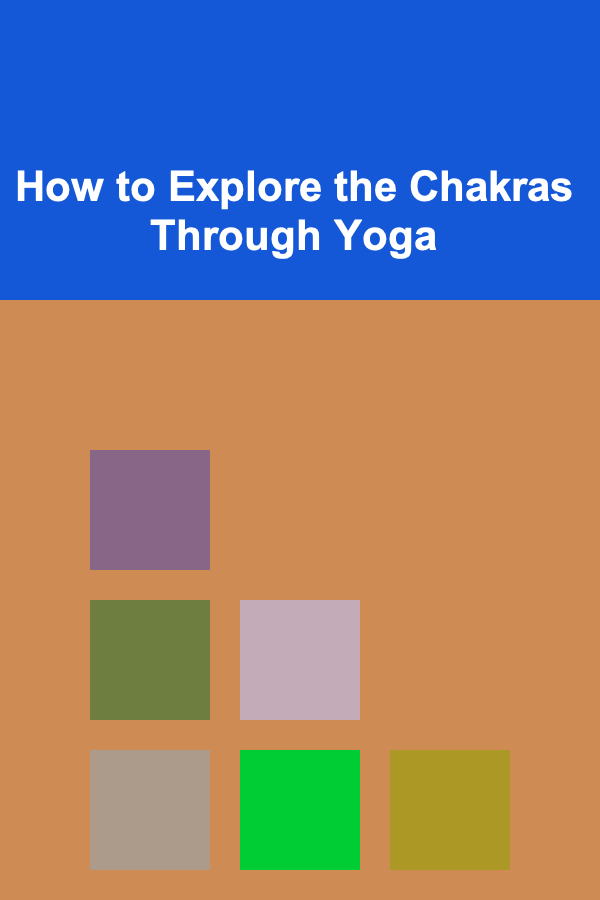
How to Explore the Chakras Through Yoga
ebook include PDF & Audio bundle (Micro Guide)
$12.99$6.99
Limited Time Offer! Order within the next:

Yoga, an ancient practice with roots in India, offers much more than just physical exercise. It provides a comprehensive approach to achieving holistic well-being, encompassing the mind, body, and spirit. One of the most profound ways yoga affects us is through its exploration of the chakras --- the seven energy centers within the body that influence our physical, emotional, and spiritual health. This article delves into how yoga can help us explore and balance these chakras to foster better health, vitality, and emotional equilibrium.
The Concept of Chakras
The term "chakra" is derived from the Sanskrit word for "wheel," signifying the spinning vortex of energy that flows through our body. These energy centers are not tangible, but rather metaphysical points that govern different aspects of our being, both physical and emotional. There are seven primary chakras, each associated with a specific area of the body, a set of emotions, and a corresponding color. Understanding these chakras and how to balance them is essential in yoga, as it promotes not only physical flexibility but also emotional and spiritual harmony.
The seven main chakras are:
- Root Chakra (Muladhara): Located at the base of the spine, it is associated with survival, grounding, and stability.
- Sacral Chakra (Svadhisthana): Located just below the navel, it is linked with creativity, pleasure, and emotional balance.
- Solar Plexus Chakra (Manipura): Located in the stomach area, it governs personal power, confidence, and self-control.
- Heart Chakra (Anahata): Situated in the chest, it represents love, compassion, and emotional healing.
- Throat Chakra (Vishuddha): Located in the throat, it is the center of communication, self-expression, and truth.
- Third Eye Chakra (Ajna): Located between the eyebrows, it governs intuition, wisdom, and clarity of perception.
- Crown Chakra (Sahasrara): Located at the top of the head, it connects to higher consciousness, spirituality, and divine wisdom.
Each chakra has its unique influence, and when these centers are balanced, we experience optimal health and well-being. When they are blocked or out of alignment, however, it can lead to emotional, physical, or psychological issues. Yoga, with its combination of asanas (physical postures), pranayama (breathwork), meditation, and visualization, offers an effective means of exploring, balancing, and activating these chakras.
The Role of Yoga in Chakra Exploration
Yoga is a powerful tool for exploring the chakras because it encourages both physical movement and deep mindfulness. As we engage in various yoga practices, we not only stretch and strengthen the body but also cultivate awareness of the subtle energies flowing through us. This awareness is essential when working with the chakras, as it enables us to detect areas where energy may be blocked or stagnant.
The connection between yoga and chakras lies in the principle that movement and breath can influence energy flow within the body. Each yoga posture, when practiced mindfully, can open, activate, or balance the chakras. Additionally, specific breathing exercises (pranayama) and meditation techniques can be used to focus energy on particular chakras, facilitating their healing and activation.
1. Root Chakra and Yoga: Stability and Grounding
The first chakra, the Root Chakra (Muladhara), is located at the base of the spine and is responsible for our sense of stability, safety, and connection to the earth. When this chakra is balanced, we feel grounded, secure, and at ease in our environment. However, when it is blocked, we may experience feelings of insecurity, fear, or restlessness.
In yoga, the Root Chakra is activated and balanced through grounding poses that connect us to the earth. Poses like Mountain Pose (Tadasana), Warrior Pose (Virabhadrasana), and Tree Pose (Vrksasana) help promote a sense of stability and rootedness. These poses strengthen the legs and feet, providing a physical foundation for cultivating mental and emotional security.
Pranayama techniques such as Deep Belly Breathing (Diaphragmatic Breathing) can also support the Root Chakra. This breathing practice involves fully engaging the diaphragm and filling the belly with air, which helps bring awareness to the lower part of the body and promote feelings of safety and grounding.
2. Sacral Chakra and Yoga: Creativity and Emotional Flow
The second chakra, the Sacral Chakra (Svadhisthana), is located just below the navel and is associated with creativity, pleasure, and emotional balance. A blocked Sacral Chakra can lead to feelings of emotional numbness, lack of creativity, or difficulty in relationships.
To activate the Sacral Chakra in yoga, focus on hip-opening postures such as Butterfly Pose (Baddha Konasana), Pigeon Pose (Eka Pada Rajakapotasana), and Child's Pose (Balasana). These poses encourage flexibility and fluidity in the hips, promoting the free flow of energy through this chakra.
Breathing techniques like Ujjayi Breath (Victorious Breath), where the breath is controlled and audible, can also stimulate the Sacral Chakra. This breath encourages a slow, rhythmic flow of energy throughout the body, enhancing emotional stability and creativity.
3. Solar Plexus Chakra and Yoga: Personal Power and Confidence
The third chakra, the Solar Plexus Chakra (Manipura), is located in the upper abdomen and governs personal power, self-confidence, and the ability to take action. When this chakra is balanced, we feel empowered, motivated, and able to assert ourselves. An imbalanced Solar Plexus Chakra can lead to feelings of powerlessness, low self-esteem, or indecision.
Yoga poses that strengthen the core, such as Boat Pose (Navasana), Plank Pose (Phalakasana), and Locust Pose (Salabhasana), are excellent for activating the Solar Plexus Chakra. These poses engage the abdominal muscles and help to build strength and confidence.
Breathing exercises like Kapalbhati (Breath of Fire) are particularly effective for stimulating the Solar Plexus Chakra. This dynamic breath involves rapid exhalations and passive inhalations, which energize the digestive system and increase vitality, boosting personal power and clarity of mind.
4. Heart Chakra and Yoga: Love and Compassion
The fourth chakra, the Heart Chakra (Anahata), is located in the chest and is associated with love, compassion, and emotional healing. A balanced Heart Chakra allows us to give and receive love freely, without fear or judgment. When blocked, we may experience feelings of isolation, grief, or a lack of empathy.
To open the Heart Chakra in yoga, focus on heart-opening poses such as Camel Pose (Ustrasana), Cobra Pose (Bhujangasana), and Bridge Pose (Setu Bandhasana). These postures expand the chest, helping to release stored emotional tension and promote love and compassion.
Pranayama practices such as Anahata Pranayama (Heart Centered Breath) can further activate the Heart Chakra. This involves inhaling deeply while visualizing the color green, which is associated with the Heart Chakra, and exhaling with a sense of openness and love.
5. Throat Chakra and Yoga: Communication and Self-Expression
The fifth chakra, the Throat Chakra (Vishuddha), is located in the throat and governs communication, self-expression, and the ability to speak our truth. A balanced Throat Chakra enables us to communicate clearly and authentically. An imbalance may result in difficulty expressing ourselves, fear of speaking up, or feelings of being misunderstood.
To activate the Throat Chakra in yoga, practice poses that open the neck and throat, such as Fish Pose (Matsyasana), Plow Pose (Halasana), and Shoulder Stand (Sarvangasana). These poses help release tension in the neck and encourage vocal expression.
Breathing techniques such as Bhramari (Bee Breath), where the sound of a bee's hum is created during exhalation, can also help activate the Throat Chakra. This sound vibration resonates through the throat, stimulating communication and self-expression.
6. Third Eye Chakra and Yoga: Intuition and Clarity
The sixth chakra, the Third Eye Chakra (Ajna), is located between the eyebrows and governs intuition, wisdom, and inner vision. A balanced Third Eye Chakra enhances clarity, insight, and spiritual awareness. An imbalance can lead to confusion, lack of direction, or difficulty trusting one's intuition.
To activate the Third Eye Chakra in yoga, practice poses that involve forward folds, such as Child's Pose (Balasana), Seated Forward Fold (Paschimottanasana), and Wide-Legged Forward Fold (Prasarita Padottanasana). These poses encourage a gentle inward focus, helping to stimulate the intuitive center.
Meditation practices that involve focusing on the space between the eyebrows, coupled with Nadi Shodhana (Alternate Nostril Breathing), can help balance the Third Eye Chakra. This practice calms the mind and opens the path to higher consciousness and spiritual clarity.
7. Crown Chakra and Yoga: Spiritual Connection
The seventh chakra, the Crown Chakra (Sahasrara), is located at the top of the head and connects us to divine consciousness and higher wisdom. A balanced Crown Chakra allows us to experience spiritual enlightenment and a sense of oneness with the universe. When blocked, we may feel disconnected or spiritually lost.
To activate the Crown Chakra, practice poses that promote deep relaxation and alignment, such as Savasana (Corpse Pose) and Lotus Pose (Padmasana). These poses help quiet the mind and create space for spiritual insight.
Meditative practices, such as Chanting Mantras or focusing on the color violet, can also stimulate the Crown Chakra. As you meditate, visualize a lotus flower blooming at the top of your head, symbolizing your connection to higher consciousness.
Conclusion
Exploring the chakras through yoga is a profound journey that fosters balance, healing, and spiritual growth. By practicing specific poses, breathwork, and meditation techniques, we can unlock the energy centers within our bodies, leading to enhanced well-being and a deeper connection to our true selves. Through this practice, yoga offers a pathway to align the mind, body, and spirit, creating a harmonious flow of energy that empowers us to live more fully and authentically.

How to Manage Multiple Properties Without Losing Control
Read More
How to Renovate Your Home to Create a More Open, Airy Feel
Read More
How to Stay Compliant with Local Laws When Renting on Airbnb
Read More
How to Use Professional Photography to Make Money
Read More
How to Learn About Superconducting Quantum Computers: A Comprehensive Guide
Read More
Building a Relationship That Lasts a Lifetime
Read MoreOther Products

How to Manage Multiple Properties Without Losing Control
Read More
How to Renovate Your Home to Create a More Open, Airy Feel
Read More
How to Stay Compliant with Local Laws When Renting on Airbnb
Read More
How to Use Professional Photography to Make Money
Read More
How to Learn About Superconducting Quantum Computers: A Comprehensive Guide
Read More